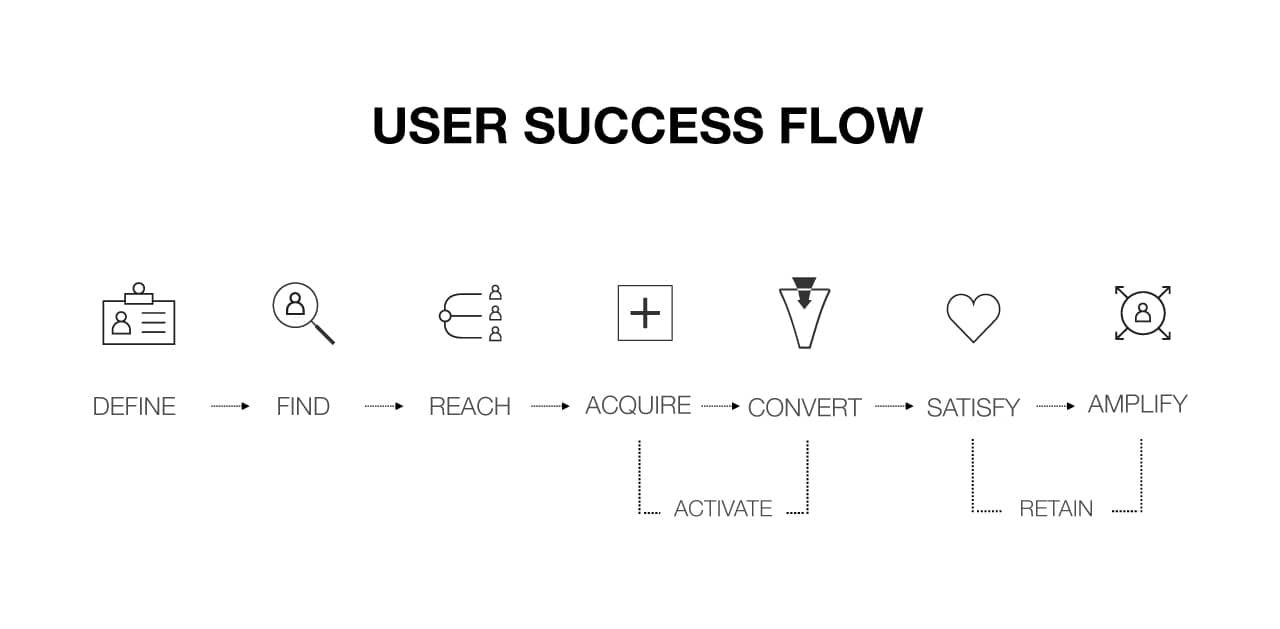Life’s too short to build something nobody wants
– Ash Maurya, Running Lean.
Summary
Mapping Out the User Success Flow in 7 Steps
As entrepreneurs, too often we concentrate on the actual product or service we try to bring into the market, wishing for this product to turn out as good as possible. We fall in love with our solutions too early and too deeply many times, instead of concentrating on the actual problem we want to solve, who’s really dealing with it, and how critical it actually is.
Sometimes we tend to forget that a product cannot stand without its user base. It has no reason to exist, unless people find it useful or delightful or interesting or all of the above. In order to build a solid foundation for your business, you have to really look at your customers and find out what their wants, needs, and pains are. Knowing what they like and what they dislike will enable you to design a suitable mobile product, one that people will actually appreciate.
The User Success Flow
If we take a look at Peter Drucker’s insight on the purpose of a business – “To create a customer” – we could conclude that a business exists to create successful new ways for its customers. Consequently, its fundamental focus should be on creating some sort of a User Success Machine that works.
To this end, we came up with a useful framework called The User Success Flow. Its purpose is to help both entrepreneurs and marketers map out the entire territory of defining a target audience, finding suitable channels to reach an audience, using tactics that drive conversion, up to the point of customer satisfaction and, hopefully, amplification. The process contains 7 crucial steps, which we will be discussing in detail below. Let’s get started.

1. DEFINE
Who is your target audience?
Defining the right customer base is especially important for a startup. Having limited resources, but also a limited amount of knowledge on how your product will “behave” in its given market, it is crucial for a startup to know who its early adopters are.
Early adopters are the ones to accept the product quickly, giving entrepreneurs precious insight into business or product adjustments that might be necessary, while also funding the next steps by creating actual traction with the business.
Here is how we define the customer base we are looking to work with for the different projects we’re on. It entails a first segmentation of the user base, a more refined profiling of the user base, and lastly, a really detailed profiling. These are the three stages to go through:
- User segment
- User profile
- User persona
USER SEGMENTS

Simply dipping your toes into the waters of your chosen market won’t do. Carefully analyzing who your target customers are will make for a beautiful, and most of all useful, market segmentation.
This business process entails dividing a large, homogenous market into clearly defined and identifiable subdivisions. It’s what we call customer segments, consisting of people with similar needs, wants, or other demand characteristics. This market breakdown will enable you to choose the customer segments that your company is best equipped to serve, thus investing your marketing efforts wisely. You’ll be looking at a clearly identifiable and measurable customer base, that is accessible for you and that is more likely to respond to your communication (and selling) efforts.
There are four criteria you need to consider when doing a market segmentation. You’ll differentiate your preferred customer segment from a behavioral, demographic, psychographic, or geographical point of view. It is up to you to pick the strategy that is best suited to your business.
USER PROFILES

While remembering that a target customer is still under no obligation to buy your product or engage with your service in any way, targeting a specific customer base is a smart business move. Actually, scratch that – it’s a crucial business move. Let’s see how profiling the user might work like.
For starters, think big. Don’t limit yourself to the most obvious kind of customer. He or she might still be relevant at the end of this audience brainstorming session, but it’s important to be aware of all the options out there. Who are the people that could benefit from your offer? Write it down.
Next, it’s time to assess who stands out from the crowd of potential customers for your business. Pick the right ones to reach out to by looking at the potential value that each of these customer segments holds for your business. In order to do so, you have to look really close at these potential customers. There are a few specific attributes you should take into consideration, including:
- Demographics (people’s gender, age, level of education, household income and location, urban or rural)
- Mindset (analyzing their approach to life, their beliefs and attitudes, including towards your field of business; ask yourself, is your business’ communication tone suitable for them?)
- Interests
- Social life
- Work
- Replacement tools (see if there’s room for your solution within the existing set of comparable products)
- Frequency (with which people make use of the benefits you’re offering; don’t set your expectations higher than necessary, as in the end, your revenue stream is the one that’ll take the hit).
USER PERSONA

Creating user personas is a fun and highly efficient way of summarizing all the information you have gathered on a specific user segment, thus making it so much easier for anyone else involved to better grasp what characterizes this user profile. Looking at people this way – a specific someone, as opposed to a generic anyone – will aid you in designing your product and your communication efforts, by turning this cohort of people into a manageable and memorable entity.
The fundamental reason for creating a user persona is to positively influence your understanding of your customer base. How you do this is ultimately up to you. Usually, it’s a one-page document presenting the essentials of a prototypical customer: wants and needs, skills, the person’s key goals and a “day in the life” short story. Adding a picture and giving your user persona a name will not only give it that little something extra, but it will make a world of difference in remembering the user persona, making it stand out even more.
2. FIND
Where does your target audience spend time daily?

Having gone through the first big step of defining your customer base, you should be very close to knowing where to find it, physically, digitally, and even behaviorally. Where you can find your target audience also defines how to best reach it. Communicating with a teenager coming from a rural setting is not the same as communicating with a senior from an urban setting.
Remember us telling you previously about the user persona one-page document and how it contains a “day in the life” short story? Laying down what your target audience is up to throughout the day is very helpful in establishing what communication channels and tactics might work best for you. Start by asking yourself these questions:
- Where do you spend the majority of your time in a day?
- What is it that you do throughout the day?
- Who are you with?
Think about what you’re doing Monday through Friday, and how you like to spend your weekends – consider the most average of your days, as well as the days when you’re attending certain events, and so on. As you did this exercise on yourself, do it for your user base and figure out where to find them in order to communicate with them most efficiently.
3. REACH
What communication channels and tactics should you use?

There are two fundamental questions you need to answer in order to move forward:
- Which are the communication channels best suited for your user base?
- What are the communication tactics most engaging for this customer base?
Picking the right channels to engage in a conversation with your audience is crucial for your marketing efforts. This again is something you determine by looking closely at your customer base: who are the people you are trying to connect with and which are the channels they mostly use? These are the channels you should be using as well.
If you’re dealing with existing customers or people simply interested in your products, look at how they found out about you in the first place. Was it social media, was it outdoor banner ads, was it other happy customers? Knowing where your audience is coming from will further aid you in establishing the essential characteristics that define your user base.
Still, simply finding out where your audience is and what channels reach your audience best won’t get the job done. The messages you are getting through to your target audience will make a real difference in the outcome of your marketing efforts.
Get creative. Again, look at the user personas you are dealing with:
- What are the information bits and pieces that would make their day, that would be really helpful or simply entertaining?
- What kind of content is a particular channel suitable for?
- What are the characteristics of the people using this channel? Look for data to help you decide on a message and how you’re gonna wrap it up.
Look at the data gathered by your marketing efforts. See if the delivered content attracted the right audience and what pieces of content got the most engagement from your users. Take notes of what tactics prove to be most effective and why. After doing this for a while, you’ll know what it is that makes your audience click with your content.
4. ACQUIRE
Get your customers closer to you. Convince them to interact with your product/service.

As much as you want your audience to click with your content, in the end, it’s your offer (be it a product or a service) you want your audience to appreciate and buy. How will you get your users right in front of your offer?
Keep in mind that everything about your communication tactics should be inviting the user to engage, to dig deeper. Engaging content is an excellent tactic and should not be underestimated. Every piece of engaging content should say something about your venture: your brand and your stance, your products and your work ethic. Other tactics might include:
- SEO (Search Engine Optimization)
- SEM (Search Engine Marketing)
- SMM (Social Media Marketing)
- Email Marketing
- Utility Marketing
- Native Advertising
Communicate openly and efficiently. Operate your tactics wisely in order to activate your target audience from a latent one, to a consumer one.
5. CONVERT
Convince users to take the necessary steps to reach your goal.

We’ve learned that knowing your target audience is key to effective communication. Similarly, you have to know and understand the acquisition flow your target audience has to undertake in order to become an official customer.
Say you’re operating a bakery. What are the stages your average customer has to go through in order to become an actual buying customer? Maybe it’s something like this:
John Doe is walking down the street in his Nikes, when the super-yummy smell of your very own chocolate chip bread hits his nostrils. He has no choice but to enter the building. Now he is faced with a variety of delicious looking breads and pastries; a decision is about to be made. Any help with this? He’ll probably scan the name tags of the products, maybe their ingredients as well. After carefully contemplating the amount of calories each of these products has, John remembers that it’s his cheat day. So, he orders two of the chocolate chip bread; his girlfriend Jane will surely appreciate it. Order’s up, money’s on the table. John leaves your bakery smiling, enjoying his chocolatey treat.
Doing a visualization exercise like this is a very useful tactic. It’ll enable you to imagine yourself in your customer’s shoes. And if you’re doing it right, it’ll give you valuable info about what it takes for them to become an actual paying customer.
- What are the stages of your customer acquisition flow?
- Are there any impediments the customer has to deal with?
- At which points could your customer cut off the entire decision making process?
- Is there anything you can do to influence any of these points?
6. SATISFY
Meet and exceed user expectations. Bring delight.

You’ve identified your target audience well, you’ve established the right channels to use for your communication tactics, and you’ve managed to work up some really nice, engaging content. Your target audience reacted really well to your marketing efforts and you got them to convert to real, buying customers. But will they be happy with the product? Hopefully, you did everything in your power to ensure that they will.
Gathering feedback related to customer satisfaction is a best practice we advise you to implement. If your customers were happy with the products or services, it’ll be good news. If they weren’t, the good news is that you can still use this to your advantage, by optimizing accordingly.
7. AMPLIFY
Create value worth sharing with others.

If your customers were happy with the products, you might have this amplifying part covered. No one is under any obligation to suggest your products to anyone else, but if they really enjoyed using them, you might get lucky.
Nonetheless, since leaving things up to fate is rarely a best practice in the business world, even more so in the startup world, there are a few guidelines for you to keep in mind.
Ever heard of the Customer Delight Pyramid? It consists of three blocks representing the three aspects a customer uses to evaluate you, when it comes to the level of delight working with you brought him. First of all, you’ll want to meet the customer’s needs. Secondly, the entire process has to be as easy as possible. Lastly, you’ll need to add some delight to your customer’s life. Bringing delight to your application does not have to be some tricky thing. It’s the small things that count.
Say your product is visually polished to a T and is a delight to look at, or you have different bits and pieces of micro copy popping out at the exact right time, getting your customer in a good mood. Don’t shy away from getting personal; everything about the looks and works of your product should say something about your business as a brand, and should fit the customer base it’s meant for. Humor and fun surprises are always a good idea, if used wisely. Even something as annoying as a “Page not found” error message can be turned into something amusing and delightful with the right copy.
Exceeding the customer’s expectations of the product itself, or of the entire process of working with you, will definitely improve your chances of being recommended. Remember Dropbox giving you up to 16GB of free extra space if you recommended the service to your friends?
They created a win-win situation: you got the extra storage space, and they got a lot of extra user base. That is what you’d call a smart referral move. Think of referral tactics you could implement for your own business.
Extensive research goes to show that the NPS (Net Promoter Score) acts as an indicator of growth. Use this measurement tool to improve your business’ performance. “How likely is it that you will recommend X (a brand) to a friend or colleague?” is what you’ll want to ask your customers. Based on their answers, you’ll group your respondents as follows:
- Promoters, scoring 9-10, are the ones loyal to the brand, definitely referring others in the future;
- Passives, scoring 7-8, are satisfied but unenthusiastic customers, vulnerable to the competition’s offer;
- Detractors, scoring 0-6, are the unhappy, unsatisfied customers, who can bring damage to the brand by negative word-of-mouth.
Calculating the NPS entails subtracting the percentage of detractors from the percentage of promoters. The result should be anywhere between -100 and 100. What you’ll want to do is ensure that your score is a lot closer to 100 than to the other end, while remembering that the chances of you reaching a NPS of 100 is close to impossible. Some of the highest-performing organizations are situated somewhere between +50 and +80. Still, values may vary considerably from market to market and from one culture to another.
Bottom Line: A 7-Ingredient Recipe for Success
Use this customer acquisition tool to map out the entire process of interacting with your customers successfully. Make sure you know them as well as you can, in order to communicate with them efficiently – via the right channels, using the right tactics. Make sure the entire conversion process is laid out properly, to make it as simple and smooth as possible. Finally, take care of what customer satisfaction entails, in order to assure positive word-of-mouth for your brand. Using this tool properly will benefit both you and the customers. Implement it wisely.
Do you have questions on how to build your mobile startup?
Let’s schedule a 30-mins chat with one of our mobile product specialists.
It’s FREE and with no strings attached.

Sinziana Chitea
Content Marketer
Content Marketing Specialist, teasing everyone into taking cute pictures for Instagram. Discovering the tech world bit by bit, and writing it all down on the agency's blog. Enthusiastic about everything visual. And sweets and dogs.
















